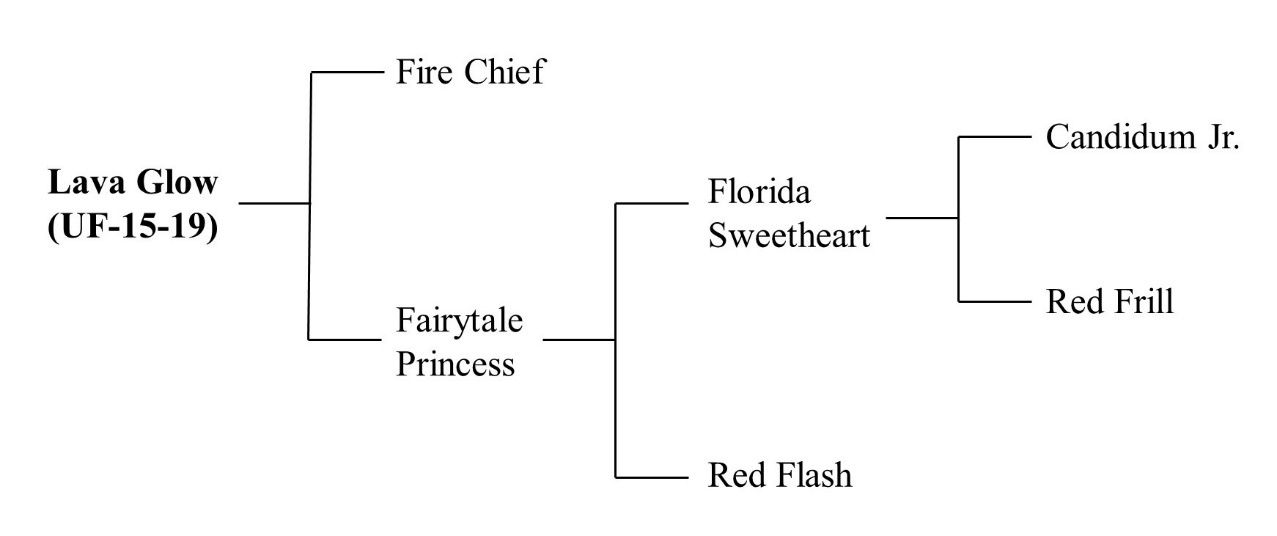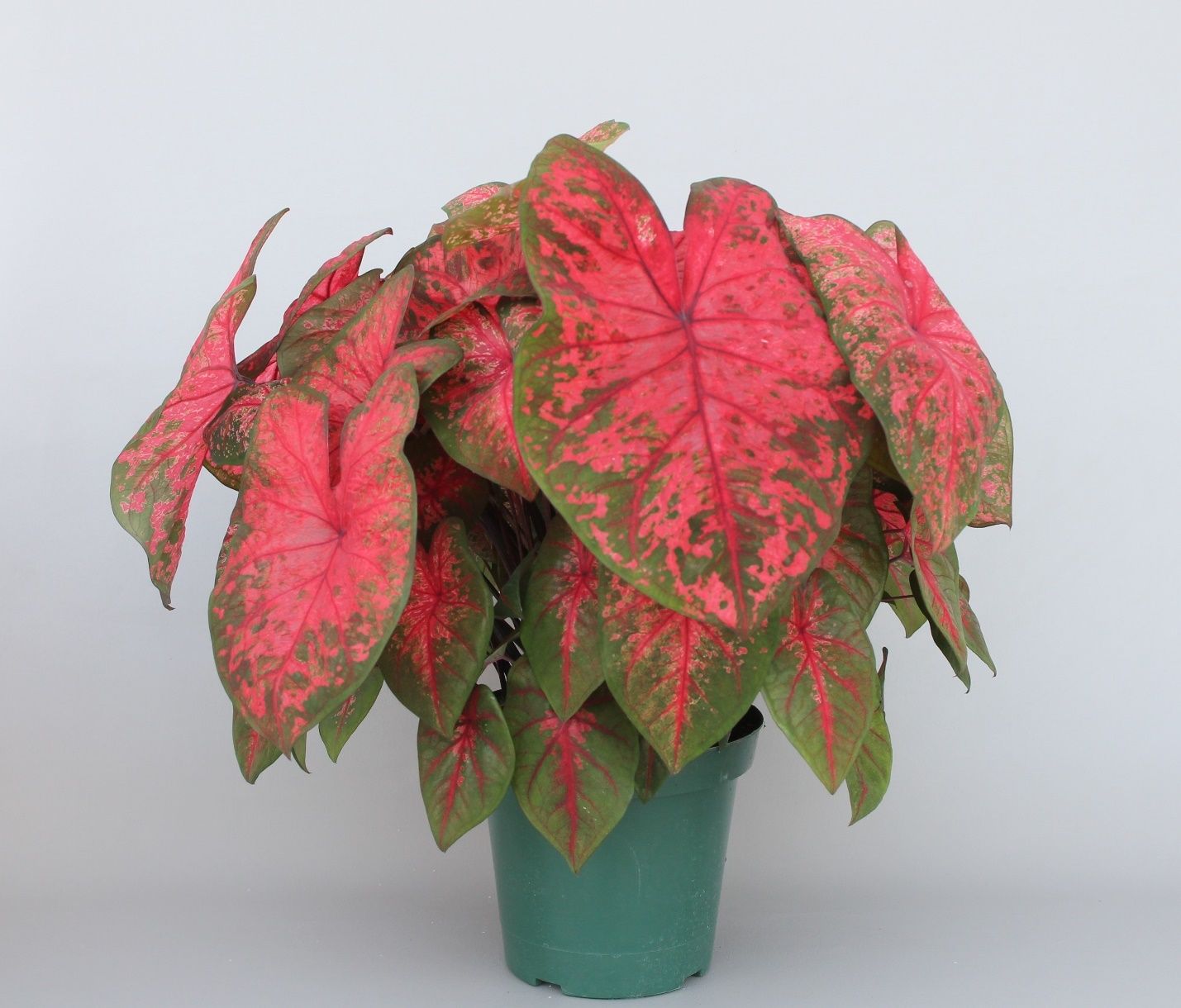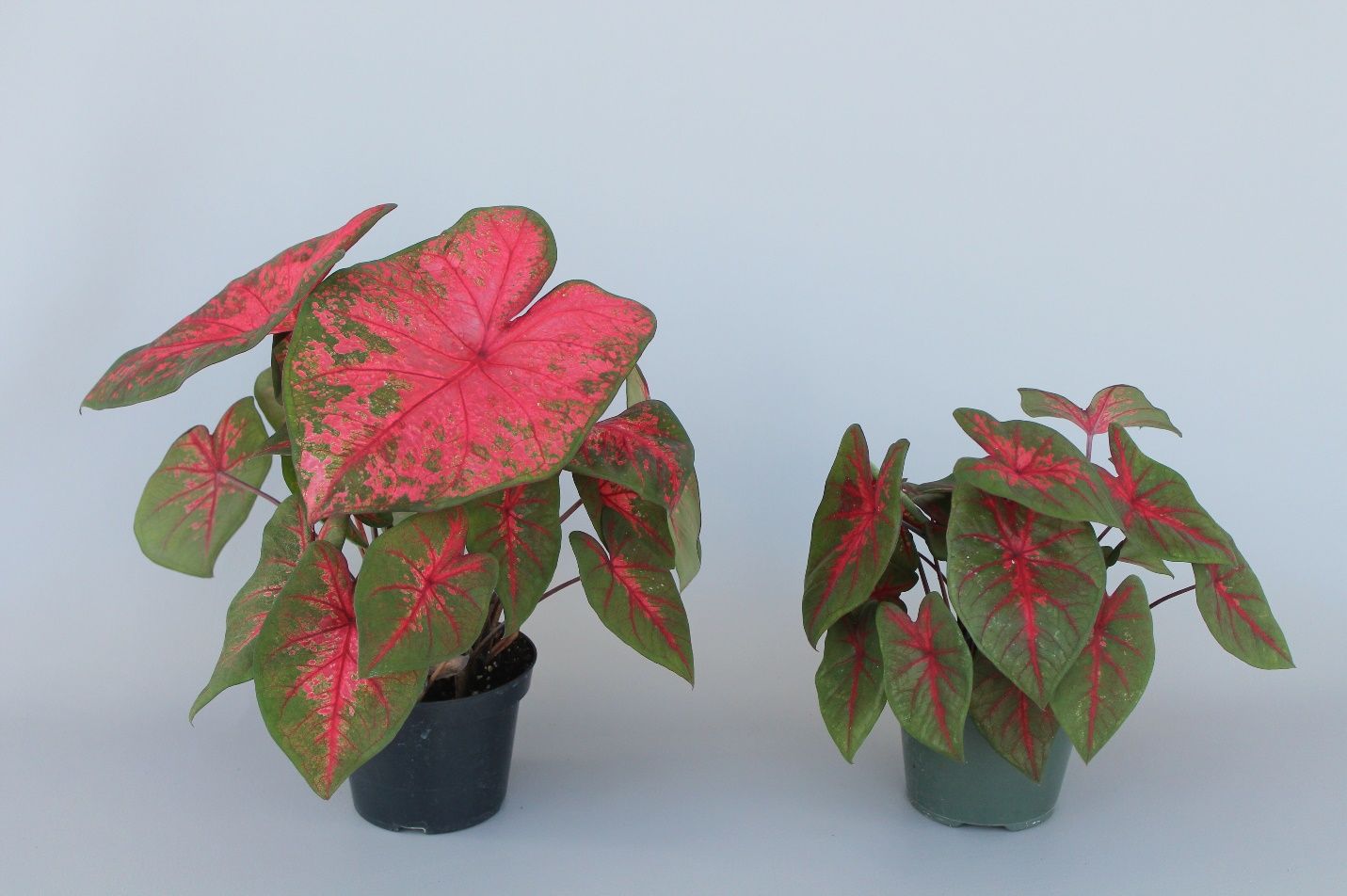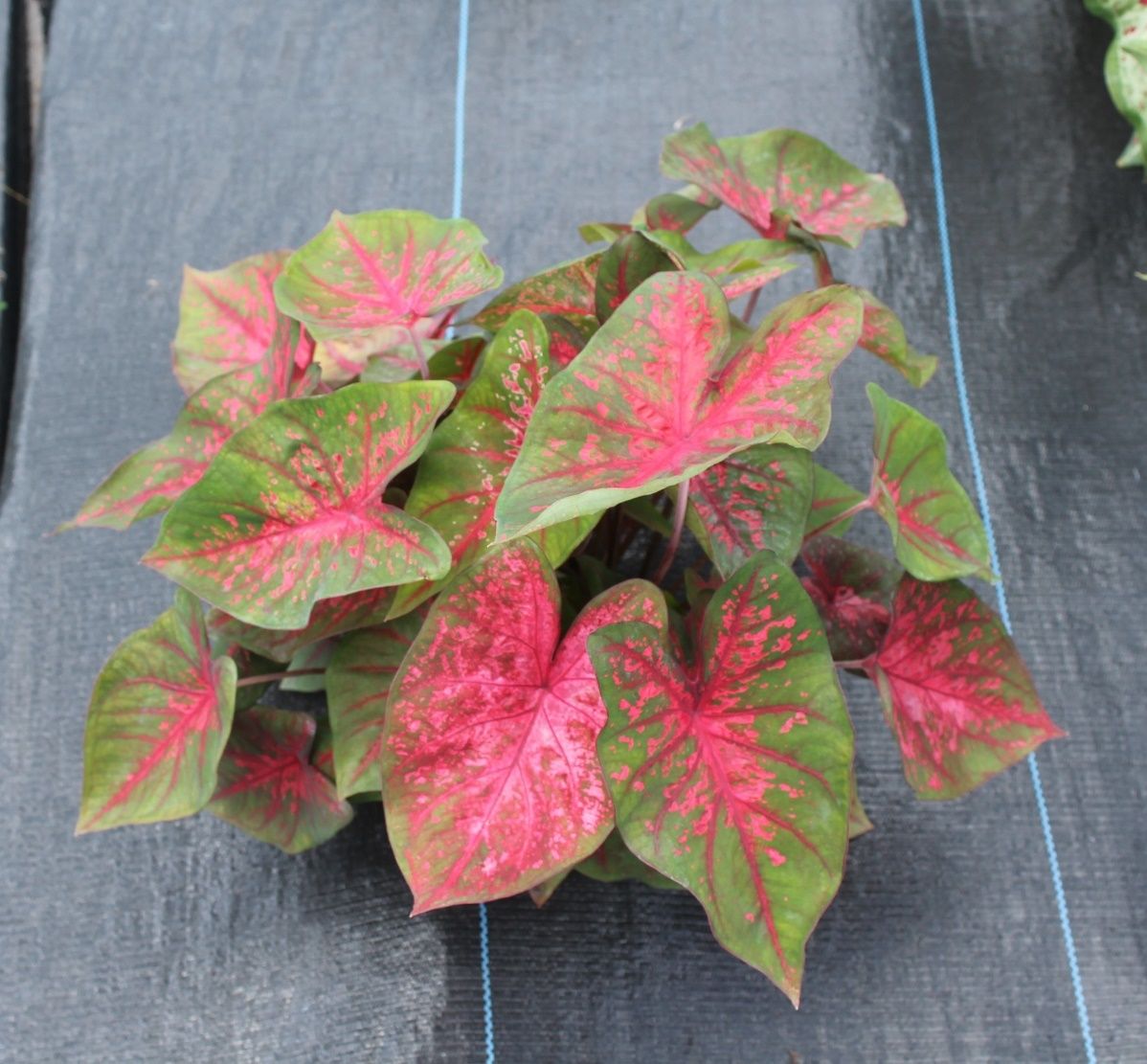Caladium has been a signature specialty crop in Florida. It is also one of the most valuable floriculture/nursery plants in the state. Every year Florida caladium growers supply all the caladium tubers used by greenhouse growers, nurseries, landscapers, and gardeners across Florida and in almost every other continental state in the United States. Continuous introduction of new caladium cultivars with novel plant and foliar features is essentially important to the Florida caladium industry. ‘Lava Glow’ is a new and novel caladium cultivar that was released in 2020 under the name ‘UF-15-19’ by the UF/IFAS’s caladium breeding program at the UF/IFAS Gulf Coast Research and Education Center (GCREC) in Wimauma, FL. ‘Lava Glow’ plants produce bright red to red-purple heart-shaped leaves with strong sunburn tolerance, and they are resistant to leaf spot diseases. ‘Lava Glow’ is well suited for use in containers, small to large, and planting in landscapes from full-sun to shady locations. This cultivar has shown good tuber yield potential, its tubers are well branched, and de-eyeing may be optional for producing plants in small containers. With these features, ‘Lava Glow’ can further enrich the plant palette for caladium growers, nurseries, landscapers, and gardeners. This article is prepared for growers who are interested in growing caladium as a horticultural crop and for greenhouse or nursery growers who are interested in producing potted caladium plants. A more detailed description of ‘Lava Glow’ can be found in the HortScience journal article by Deng et al. (2023).
Origin
‘Lava Glow’ originated from a cross between ‘Fire Chief’ and ‘Fairytale Princess’ (Figure 1). ‘Fairytale Princess’ was progeny of a cross between ‘Florida Sweetheart’ and ‘Red Flash’ (Deng et al. 2013). ‘Fire Chief’ and ‘Red Flash’ are nonpatented commercial cultivars, and their ancestry is unknown. ‘Fairytale Princess’ was released in 2012 (Deng et al. 2013) and is a patented cultivar (USPP 25,612). ‘Florida Sweetheart’ (Wilfret 1991) was a patented cultivar (USPP 8,526), but the patent has expired. ‘Lava Glow’ was initially selected in September 2015 as breeding line N1403-1, which was recoded as 15-19 in April 2016. First asexual propagation of ‘Lava Glow’ occurred in Wimauma, FL in spring 2015; since then, it has been asexually propagated through tuber division for five generations. Plant, foliar and growth characteristics of ‘Lava Glow’ have been stable and consistent during asexual propagation.

Botanical Description
‘Lava Glow’ plants forced from four intact No.1 tubers in 8-inch containers for approximately 8 weeks have an average height of 16.9 inches and an average width of 26.4 inches (Figure 2). Mature leaves are heart-shaped with two large lobes and palmate-pinnate veins on the main blade. Primary and secondary veins are red. The upper surface has a green margin, up to 0.4 inches wide, bordering the entire leaf except for the basal leaf sinus, where it is red. Interveinal areas in the center of the leaf blade are red. Numerous irregular spots and blotches of different sizes in red are located between the large red center and the margin. The undersurface has a primarily red-purple center with red-purple primary veins. Numerous small blotches and spots of red-purple are located between the center and the margin. Petioles are dark brown variably streaked with light brown, light purple and deep red-purple. Tuber surfaces are grayed-orange with the cortical area yellow-orange.

Credit: K. Druffel, UF/IFAS
Tuber Yield Potential
‘Lava Glow’ was evaluated for tuber yield potential in small replicated experimental field plots at GCREC in Wimauma, FL in 2018 and 2019. The soil was EauGallie fine sand with about 1% organic matter and a pH value between 6.2 and 7.4. Caladium plants were grown in the field plots using a white-plastic-mulched raised-bed system (Deng and Harbaugh 2006). In the 2018 season, ground beds (32 inches wide, 8 inches high) were fumigated on 13 February with Pic-Clor 60® (39.0% 1,3-dichloropropene and 59.6% chloropicrin) at 400 lb per acre and Prowl® H20. Caladium seed tubers were treated in hot water (122°F) for 30 minutes. Seed tuber pieces were dusted with a biological fungicide RootShield® Plus WP (BioWorks, Victor, NY) and planted manually on 27 April at 6-inch spacing between rows and in rows. Fifty pounds of granular nitrogen per acre was incorporated into the soil prior to bedding. Two drip tapes were buried under the plastic mulch along the raised beds for irrigation and fertilization. Fertigation began on 29 May, injecting a commercial liquid fertilizer (5N-0.87P-6.64K, Chemical Dynamics, Plant City, FL) at the rate of one pound of nitrogen an acre a day, and stopped on 31 October. New crop tubers were dug and washed on 17 December and air-dried for approximately 50 days inside a greenhouse. Dried tubers from each experimental field plot were weighed, graded, and counted on 6 February 2019. Tuber grading was conducted by measuring the maximum diameter: Mammoth (3.5 to 4.5 inches), Jumbo (2.5 to 3.5 inches), No.1 (1.5 to 2.5 inches), and No.2 (1.0 to 1.5 inches). Tuber grades and counts were converted into a production index to show the relative economic value of the harvested tubers per field plot: Production index = 6n (Mammoth) + 4n (Jumbo) + 2n (No.1) + 1n (No.2), where n = number of tubers in the grade. The relative values assigned to the five tuber grades in calculating production index were based on the relative market prices provided by Florida caladium tuber producers.
For the 2019 evaluation, beds were fumigated on 24 February with Pic-Clor 60® at 400 lb per acre. Caladium seed pieces were planted on 4 April. Fifty pounds of granular nitrogen per acre was incorporated into the soil prior to bedding. Fertigation began on 1 June, by injecting a commercial liquid fertilizer (5N-0.87P-6.64K, Chemical Dynamics) at one pound of nitrogen an acre a day. The fertilization rate was increased to two pounds of nitrogen an acre a day on 24 July and ended on 31 October. Tubers were dug and washed on 9 December, dried in the greenhouse for approximately 45 days, and weighed, graded, and counted on 21 January 2020, using the same protocol that was used in 2018.
In both growing seasons, the field plots were arranged in a randomized complete block design with three replicates. The plot size was 13 square ft and was planted with 30 caladium propagules (tuber pieces). ‘Freida Hemple’, a standard red fancy-leaf caladium cultivar, was included in the field trials as a check to assess the tuber yield potential and plant performance of ‘Lava Glow’. On average, ‘Lava Glow’ in the experimental plot in 2018 produced 4.3 lb of tubers, of which 33 were marketable and had a production index of 85 (Table 1). In these parameters, ‘Lava Glow’ was not significantly different from ‘Freida Hemple’. Similarly, ‘Lava Glow’ and ‘Freida Hemple’ were not significantly different in tuber weight (4.0 and 3.2 lb, respectively), marketable tubers (45 and 33, respectively), and production index (68 and 59, respectively) in the 2019 growing season (Table 1). The primary grade of tubers produced by ‘Lava Glow’ in 2018 and 2019 was No. 1 (44.1% in both years), followed by No. 2 (24.1% in 2018 and 53.1% in 2019), and Jumbo tubers (25.8% in 2018 and 2.7% in 2019). This tuber size distribution was not significantly different from that of ‘Freida Hemple’. Thus, in terms of tuber yield potential, ‘Lava Glow’ was comparable to ‘Freida Hemple’, one of the main red fancy-leaved cultivars in commercial caladium tuber production.
Table 1. Tuber weight, marketable number, production index, and grade distribution of ‘Lava Glow’ and ‘Freida Hemple’ (check) caladiums in experimental field plots in 2018 and 2019. Values presented are means of three plots with 30 propagules planted in a plot of 13 square feet.
Container Trials
The suitability of ‘Lava Glow’ for container plant production was evaluated in 2020 by forcing tubers in 5-inch containers (diameter). No. 1 tubers (intact or de-eyed) were planted on 1 May 2020 in the commercial potting mix Pro-Line 4B (Jolly Gardener, Poland Spring, ME) amended with Osmocote® fertilizer (15N-3.9P-10K, 5-6 months) at 7.25 lb per cubic yard and Micromax (ICL Fertilizers, Dublin, OH) at 0.81 lb per cubic yard. Potted tubers and plants were grown in a greenhouse with approximately 30% light exclusion. Temperatures in the greenhouse ranged from 77°F (night) to 92°F (day). Potted tubers and plants were arranged on metal benches, with a pot-to-pot spacing of 16 inches, in the greenhouse in a randomized complete block design with seven replicates. Two fancy-leaved commercial cultivars, ‘Brandywine’ and ‘Freida Hemple’, were included as checks for ‘Lava Glow’. Fungicide Subdue Maxx (Syngenta Group Company, Switzerland) was applied as a drench to all potted plants on 4 June 2020. Plant height, plant width, number of leaves, and foliar characteristics were recorded on 23–24 June 2020, approximately 8 weeks after planting. Quality of the potted caladium plants was rated on a scale range of 1 to 5, with 1 = very poor, unattractive, totally unacceptable as potted plants with few leaves, and 5 = very attractive, full plants with a symmetrical shape, an appropriate height, and many bright, colorful leaves.
Intact tubers of ‘Lava Glow’ sprouted 28 days after planting, about 12 to 13 days later than ‘Brandywine’ or ‘Freida Hemple’ (Table 2). De-eyed tubers of ‘Lava Glow’ sprouted 32 days after planting, about 9 to 10 days later than ‘Brandywine’ or ‘Freida Hemple’ (Table 2). Plants of ‘Lava Glow’ forced from intact No. 1 tubers had an average height of 12.2 inches, an average width of 15.4 inches, and an average of 20 leaves, and on average, the leaves were 9.9 inches long and 6.7 inches wide (Figure 3). Plants forced from de-eyed No. 1 tubers were 9.1 inches tall and 13.2 inches wide and had about 20 leaves, and the leaves were 6.3 inches long and 4.1 inches wide (Figure 3). ‘Lava Glow’ and the two checks, ‘Brandywine’ and ‘Freida Hemple’, were not significantly different in plant height, number of leaves, leaf length, and leaf width, except that they were significantly different in plant width (Table 2). Plants of ‘Lava Glow’ were 2 to 3 inches narrower than plants of ‘Brandywine’ or ‘Freida Hemple’. Plants of ‘Lava Glow’ from intact tubers received a quality rating of 3.9 (on a scale of 1 to 5), significantly higher than the plant quality rating of ‘Brandywine’ or ‘Freida Hemple’ (Table 2). Plants of ‘Lava Glow’ from de-eyed tubers received a quality rating of 3.4, which is not significantly different from that of the two checks. Generally de-eyed tubers produce higher-quality pot plants. However, this was not observed with de-eyed ‘Lava Glow’ tubers, because de-eyeing delayed color development on ‘Lava Glow’ leaves (Figure 3).

Credit: K. Druffel, UF/IFAS
Table 2. Plant height and width, leaf number, length and width, number of blooms (inflorescences), and plant quality of ‘Lava Glow’ in comparison with ‘Freida Hemple’ and ‘Brandywine’ (checks) grown in small containers. No. 1 tubers were planted in 4.5-inch containers (one tuber per container) and grown in a shaded glasshouse in Balm, FL in 2020. Values represent the means of seven plants (replicates) produced from intact or de-eyed No. 1 (1.5 to 2.5 inches in diameter) tubers planted individually per container.
Plant Performance in Open Fields in Full Sun
‘Lava Glow’ was evaluated for plant growth, leaf color display, sunburn tolerance and leaf health in the same field plots that were used for evaluating tuber production. Growing conditions were described above. A scale of 1 to 5 was used for rating plant growth, with 1 being very poor (few leaves and lack of vigor), 3 having acceptable plant growth and fullness, and 5 being excellent (full plants, numerous leaves). A scale of 1 to 5 was used for rating leaf color display, with 1 being very poor (dull or bleached, lack of color display), 3 having acceptable leaf color, and 5 being excellent (bright, very attractive). Sunburn tolerance was evaluated on a scale of 1 to 5, with 1 being very susceptible to sunburn (leaves having numerous sun-damaged areas or holes), 3 having acceptable tolerance to sunburns, and 5 being resistant to sunburn (no visible sun-damaged areas). Leaf health was evaluated on a scale of 1 to 5, with 1 being numerous diseased necrotic spots and completely unsightly and 5 being healthy and free of visible leaf spot disease. Evaluations of plant growth, leaf color, sunburn tolerance and leaf health were done on 27 July and 25 August 2018, and 13 July, 13 August, and 18 September 2019.
‘Lava Glow’ plants received a growth score of 2.0 to 3.8 in 2018 and 2019 growing seasons (Table 3), which were significantly higher than scores for ‘Freida Hemple’ in two out of five evaluations. Leaf color rating of ‘Lava Glow’ ranged from 2.8 to 4.3, significantly higher than that of ‘Freida Hemple’ in three out of the five evaluations (Table 3). Sun tolerance ratings of ‘Lava Glow’ plants were between 3.3 and 4.8, significantly higher than the rating scores of ‘Freida Hemple’ in two of the five evaluations (Table 4). Leaves of ‘Lava Glow’ had few diseased spots and received a health score between 3.3 and 4.7, which were significantly higher than the leaf health scores of ‘Freida Hemple’ in two out of five evaluations (Table 4).
Table 3. Plant performance and leaf color display ratings of ‘Lava Glow’ and ‘Freida Hemple’ (check) caladiums grown from 1-inch tuber propagules in ground beds in full sun in Balm, FL in 2018 and 2019. Plant performance and leaf color rating values are means of three plots based on whole-plot evaluation in each evaluation.
Table 4. Sunburn tolerance and leaf health rating of 'Lava Glow' and commercial caladium cultivar 'Freida Hemple' (check) grown from 1-inch tuber propagules in ground beds in full sun in Balm, FL in 2018 and 2019.
Plant Performance in Garden Trials
Two garden trials, one in full sun and one under shade, were conducted in summer 2020 to evaluate the plant performance of ‘Lava Glow’ against the commercial cultivar ‘Brandywine’. Garden beds were mulched with black landscape cover. Two drip tapes were laid below the landscape cover to provide irrigation. For each cultivar, three No. 1 intact tubers were planted into the beds (1 tuber per replicate) on 22 May 2020, with a spacing of approximately 30 inches. Fifteen grams of the controlled release fertilizer Osmocote® (15N-3.9P-10K, 5–6 months) were applied to each plant. Data were taken on leaf number, leaf length and width on 17 July (approximately 2 months after planting) and 14 August 2020 (approximately 3 months after planting. Plants were rated on a scale of 1 to 5 for plant growth, leaf color display, sunburn tolerance, and leaf health.
‘Lava Glow’ plants performed well under shade and in full sun, receiving a plant growth score of 4.0 to 4.7 and leaf color score of 2.7 to 3.7 (Figure 4) (Table 5). It did a little bit better in full sun than under shade, receiving higher plant growth and leaf color scores in full sun than under shade. When grown in full sun, ‘Lava Glow’ plants showed better sunburn tolerance and fewer leaf disease symptoms (higher leaf health ratings) than ‘Brandywine’. Leaves were 1–1.5 inches shorter and about 1 inch narrower than ‘Brandywine’ leaves (Table 5). When grown under shade, ‘Lava Glow’ was not significantly different from ‘Brandywine’ in plant height, width, leaf number, leaf length and width, sunburn tolerance, or leaf health, whether they were evaluated 2 or 3 months after planting (Table 5).

Credit: K. Druffel, UF/IFAS
Table 5. Plant size, growth rating, leaf size and color display rating of ‘Lava Glow’ and ‘Brandywine’ (check) caladiums in sun and shade trials in Balm, FL in 2020. Data were taken approximately two (2-m) or three months (3-m) after No. 1 tubers were planted in the ground beds in full sun or inside a screenhouse (approximately 30% light exclusion). Values presented are mean values of three replicates.
Grower Trials in Full Sun
Three Florida caladium growers evaluated ‘Lava Glow’ in their fields using their production practices and compared ‘Lava Glow’ to their main caladium cultivars. Grower trial data indicated that ‘Lava Glow’ scored 4 or 5, on a scale of 1 to 5, in plant growth, leaf color and sunburn tolerance in each month from July to October 2019 (Figure 5). ‘Lava Glow’ performed well in grower trials compared to commercial cultivars.

Credit: Z. Deng, UF/IFAS
Potential Resistance to Fusarium Tuber Rot
Fusarium tuber rot is a major postharvest disease in commercial production of caladium tubers. It is caused by the fungal pathogen Fusarium solani. The majority of caladium cultivars in commercial production are susceptible to this disease (Goktepe et al. 2007). Preliminary results from our Fusarium inoculation experiments showed that ‘Lava Glow’ was less susceptible to Fusarium tuber rot than the susceptible commercial cultivars included in the tests (‘Carolyn Whorton’ and ‘Postman Joyner’). More experiments are needed to confirm this resistance.
Availability
Plant patent will be applied for ‘Lava Glow’. Commercial production of this cultivar is required to have a licensing agreement with the Florida Foundation Seed Producers, Inc., P.O. Box 309, Greenwood, FL 32443. Information on tuber availability and licensing agreements can be obtained from the Florida Foundation Seed Producers, Inc. (http://www.ffsp.net/).
Acknowledgment
The development and evaluation of ‘Lava Glow’ caladium were funded in part by the USDA Hatch projects (Project # FLA-GCR-005065 and FLA-GCC-005507), Florida caladium growers’ “box assessment,” royalties from previously released caladium cultivars, and a budget appropriation from the State of Florida Legislature in 2012. We thank K. Druffel, T. Seijo, T. Gu, B. Decker, J. Jones, and G. Bowman for their excellent technical support, Bates Sons & Daughters, Inc., Heartland Caladiums, Inc., Classic Caladiums, LLC, and Happiness Farms for evaluating this caladium and assisting us in caladium breeding.
Literature Cited
Deng, Z., and B. K. Harbaugh. 2006. “ ‘Garden White’—A Large White Fancy-Leaved Caladium for Sunny Landscapes and Large Containers.” HortScience 41 (3): 840–842. https://doi.org/10.21273/HORTSCI.41.3.840
Deng, Z., B. K. Harbaugh, and N. A. Peres. 2013. “UF 4412 and UF 4424—Red Lance-Leaved Caladium Cultivars.” HortScience 48 (2): 239–244. https://doi.org/10.21273/HORTSCI.48.2.239
Deng, Z., N. A. Peres, and J. Desaeger. 2023. “ ‘Lava Glow’ – A Novel Red Fancy-Leaved Caladium for Containers and Landscapers.” HortScience 57 (in print). https://doi.org/10.21273/HORTSCI16937-22
Goktepe, F., T. Seijo, Z. Deng, B. K. Harbaugh, and N. A. Peres. 2007. “Toward Breeding for Resistance to Fusarium Tuber Rot in Caladium: Inoculation Technique and Sources of Resistance.” HortScience 42 (5): 1135–1139. https://doi.org/10.21273/HORTSCI.42.5.1135
Wilfret, G. J. 1991. “Florida Sweetheart, a Rose Lance Caladium for Landscape and Containers.” UF/IFAS Fla. Agr. Expt. Sta. Circ. S-380.